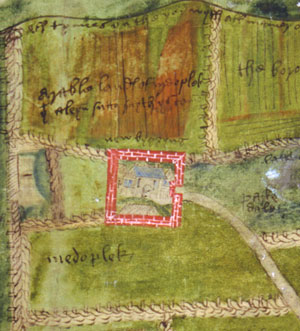 |
 |
 |
 |
 |
 |
 |
|
The acquisition of lands and possessions (2/7)
The two founders of Roche, Richard de Busli and Richard Fitz Turgis, granted the monks an initial endowment of lands with appurtenant rights, namely, a site for the abbey, arable land to farm and grow crops, pasture for their livestock, woodland for building resources, fuel and pannage. It was probably in response to the monks’ request for additional help that Richard de Busli supplemented his initial endowment with the grant of ‘Eilrichetorpe’ and North Wood, common pasture in Maltby for three hundred sheep and other animals that went out from the grange at ‘Eilrichetorpe’, and timber for the community to complete and maintain their buildings and fences.
The founders’ endowment provided the monks with the necessary resources to establish monastic life at Roche, but additional possessions were required to enable them to support and sustain a growing community. It fell to the successors of Abbot Durand (c. 1147-59) to expand Roche’s holdings. During the abbacies of Denis (c. 1159-71) and Roger of Tickhill (c. 1171-9) Roche secured patronage from local men and women, as well as from high-profile benefactors such as Henry II (1154-89), who gave one hundred acres of land in Lindrick (now known as King’s Wood), some four miles from Tickhill Castle. With the exception of Hugh of Wadworth’s abbacy (c. 1179-84) the twelfth century was a time of increasing prosperity for the abbey. Hugh’s ambitious designs to expand Roche’s holdings at Roxby landed the community in considerable debt, for the abbot borrowed extensively from the Jews of York – about £1300 – to secure Roxby grange, Lincolnshire (now in Humberside). Financial stability was restored by Hugh’s successor, Osmund (c. 1184-1213), who attained relief of their payment to the Jews from Richard I (1188-99), and secured papal and royal confirmation of the abbey’s possessions. The thirteenth century heralded a period of general economic decline; during Adam of Giggleswick’s abbacy the situation was so dire that the community complained of their plight to the pope. Their financial worries were briefly allayed in 1345 when Earl John of Warenne, admiring the beauty of the abbey and taking pity on the plight of the monks, gave the patronage and advowson of the church of Hatfield and all pertaining to it. John intended that his grant should augment the worship at Roche by supporting an additional thirteen ‘honest and literate men’, and his considerable gift, valued at seventy marks p.a., brought immediate relief to the monks. Their good fortune was, unfortunately, short-lived for upon John’s death his lands reverted to the Crown and thereafter to Edmund of Langley.(1) |
